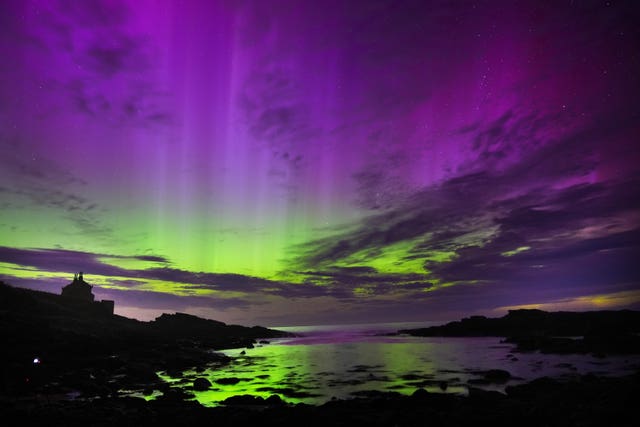Stargazers were treated to a dazzling sight as the Perseid meteor shower passed through the sky, and in some areas through the Northern Lights.
Also known as the aurora borealis, the Northern Lights put on a stunning show across the UK on Monday night, with sightings reported as far south as Cornwall.
Marina Muttik, 29, a software engineer who lives in Berkhamsted, Herts, but witnessed the Northern Lights and Perseid meteor shower from Chesham, Buckinghamshire, described the experience as “humbling”.
She told the PA news agency: “The aurora was peaking at around 11.30pm, which is when some of the pink became more visible to eye.
“It’s always humbling watching the night sky, and the Perseid meteor shower added a touch of magic – perfect for making a few wishes.”
Kirsty Louise, who is 30 and based in Plymouth, Devon, captured photos of the meteor shower on her phone at around 11.20pm on Monday.
She told PA: “Funnily enough I couldn’t actually see what I saw on my phone. When I saw the photos it made me feel happy, I absolutely love anything to do with space, so seeing that and knowing I caught it on my phone made me feel happy.”

In Northumberland, the shooting stars from the Perseid meteor shower were seen darting through the sky which had turned hues of purple and green over the Bathing House in Howick.
According to the Met Office, the Northern Lights are usually best witnessed in Scotland, northern England, North Wales and Northern Ireland.
However, under certain space weather conditions – a particularly strong geomagnetic storm – they can be seen throughout the UK.

The natural light display is caused by charged particles from the Sun interacting with Earth’s magnetic field.
The colour display depends in part on what molecules the charged particles interact with.
The Met Office forecast suggests the activity should return back to background levels on Tuesday, with any visible aurora restricted to the far north of Scotland.
Clear skies across the country also meant people were able to catch a glimpse of the Perseids on Monday night.

The event is associated with the dusty debris left by Comet Swift-Tuttle, which orbits the sun once every 133 years.
The meteoroids from the comet, mostly no bigger than a grain of sand, burn up as they hit the Earth’s atmosphere at 36 miles per second, to produce a shooting stream of light in the sky.
But the Perseids and Northern Lights are not the only show the sky is putting on, as a Mars and Jupiter conjunction is expected later this week.
A conjunction occurs when two celestial bodies appear very close to each other in the sky from our perspective on Earth.
In this case, Jupiter and Mars will appear to be almost touching, despite being millions of kilometres apart in space.
The conjunction will take place on Wednesday, and in the UK the best time to view this event is from around 2.05am until dawn.
Dr Minjae Kim, research fellow, Department of Physics, University of Warwick, told the PA news agency: “While planetary conjunctions are not extremely rare, the specific alignment and visibility conditions can make some conjunctions more special than others.
“A conjunction between Jupiter and Mars happens approximately every two years, but the exact closeness and visibility can vary depending on their orbits and the Earth’s position.
“To get the best view of the conjunction from the UK, look towards the eastern horizon before sunrise. A dark observation site away from city lights will enhance visibility.
“The brightness of the moon can also affect your ability to see other celestial objects.
“Waiting for the moon to set or observing before moonrise, if possible, might be a good idea but the conjunction will occur around 2am, so using a telescope or binoculars can provide a more detailed view, allowing you to see both planets in the same field of view is the best idea, while the conjunction should be visible to the naked eye.
“In particular, binoculars provide a wide field of view, making it easier to navigate the night sky and find celestial objects.”




Comments: Our rules
We want our comments to be a lively and valuable part of our community - a place where readers can debate and engage with the most important local issues. The ability to comment on our stories is a privilege, not a right, however, and that privilege may be withdrawn if it is abused or misused.
Please report any comments that break our rules.
Read the rules here